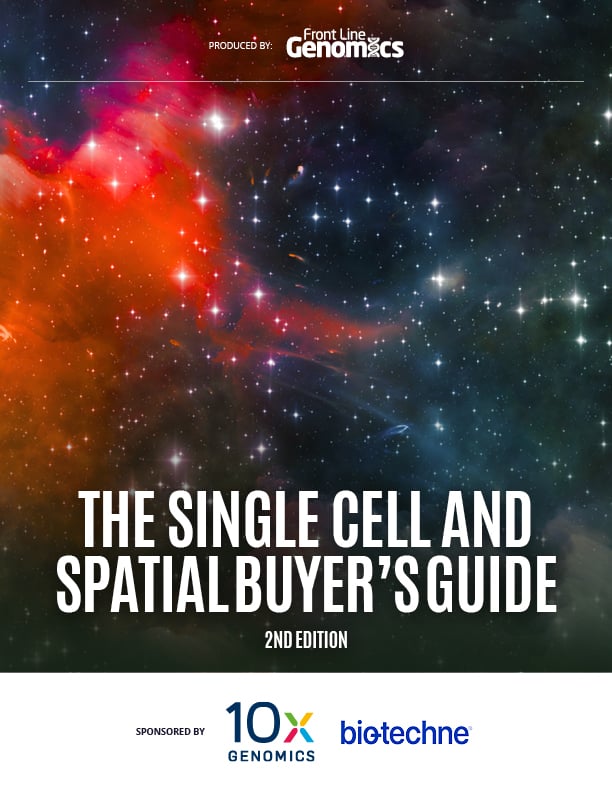
The Single Cell and Spatial Buyer's Guide: 2nd Edition
Despite still being considered emerging techniques, single-cell and spatial technologies have brought ground-breaking insights into the omics world, pushing the boundaries of our knowledge and giving vital context to previously contradictory datasets. However, navigating this landscape and making informed purchasing decisions can be a difficult task.
We are pleased to announce the launch of the latest edition of the Single Cell and Spatial Buyer’s Guide, which offers a comprehensive guide from experiment conception to final analysis in an interactive, easily navigable report.
Highlights from this buyer’s guide include:
- Interviews and panel discussions with experts covering every stage of an experiment’s lifecycle
- Up to date specifications of single cell and spatial instrumentation, displayed side by side to allow comparison, alongside reagents and kits, indicating where cross-compatibility is available
- Information on how to access global single cell and spatial communities to share wisdom and support collaborative development of the field
Hear from our Expert Contributors:
- Jasmine Plummer, Director, Center for Spatial OMICS, St Jude’s Children’s Research Hospital
- Luciano Martelotto, Associate Professor, The University of Adelaide
- Ioannis Vlachos, Director of Spatial Technologies & Bioinformatics, Beth Israel Deaconess Medical Center
- Colles Price, Associate Director, Takeda Oncology
- Mandovi Chatterjee, Deputy Director, Single-Cell Core, Harvard Medical School
- Jake Taylor-King, Co-Founder of Relation Therapeutics and Founder of scTrends
- Fabian Coscia, Group Leader, Max-Delbrück-Center for Molecular Medicine in the Helmholtz Association
- Ryan Kelly, Associate Professor, Brigham Young University
- Ruben Dries, Assistant Professor, Boston University School of Medicine
- Rajanikanth Vadigepalli, Professor and Vice Chair of Research, Thomas Jefferson University
- Aritro Nath, Assistant Professor, City of Hope National Medical Centre
- Anita Scoones, Postdoctoral Research Associate (Macaulay Group), Earlham Institute
- Louis Kümmerle, PhD Student (Fabian Theis Group), Helmholtz Zentrum München
- Stephanie Craig, Lecturer, Queen’s University Belfast
- Bokai Zhu, Postdoctoral Researcher, Ragon Institute of Mass General, MIT & Harvard
Chapter list:
Chapter 1: Single Cell Preparation and Single Cell Isolation
Understanding your starting material is key to choosing the optimal method when producing single cell suspensions for downstream processing. This chapter explores the various automated solutions for tissue disaggregation and isolation of single cells with expert guidance in navigating this choice.
Chapter 2: Single Cell Sequencing: Kits, Instruments and Workflows
The sample type and experimental question have great influence of the choice of workflow and sequencing technology. Chapter 2 offers an update on the latest technological releases and up to date specifications for existing solutions, as well as an expert ‘cheat sheet’ for deciding which technology is right for you.
Chapter 3: Spatial Transcriptomics: Kits, Instruments and Workflows
Discoveries can often be missed at single-cell resolution without the spatial context. This chapter explores when and where to use this technology, providing new and existing commercial or open-source options. We provide the latest specifications and advice from experts on which technology may suit your experimental question and its various iterations through the lifetime of a project.
Chapter 4: Single Cell and Spatial Proteomics
This chapter explores the range of proteomics workflows in the single cell and spatial fields and how challenges in obtaining this data are being addressed. The ability to perform high throughput single cell proteomics is increasing, fuelled by innovative techniques and collaborative workflows.
Chapter 5: Single Cell and Spatial Multiomics
Combining multiple modalities for single cell and spatial assays is a challenging endeavour but promises to expand our biological understanding beyond anything to date. Chapter 5 dives into the limitations and potential solutions for multiomics integration, where software seems likely to play a major role.
Chapter 6: Analysis of Single Cell and Spatial Data
Should you use the analysis pipelines that are offered with commercial technology, opt for user-friendly web interfaces or explore the wealth of open-source solutions? How much bioinformatics knowledge will you require? This chapter aims to answer these questions, providing expert advice and cutting-edge code alongside ways to manage the wealth of data these technologies generate.
Chapter 7: Outsourcing of Single Cell and Spatial Workflows
Consistency is key and outsourcing some or all of your data collection and analysis can provide many benefits. This final chapter collates the options for outsourcing each step of your single cell and spatial journey.
Download Report
ABOUT US CONTACT ADVERTISE PRIVACY POLICY
Front Line Genomics Limited is registered in England and Wales. Company Number 10421716, VAT: GB 297 742 548.
Registered Office: Newfrith House, 21 Hyde Street, Winchester, SO23 7DR, United Kingdom
